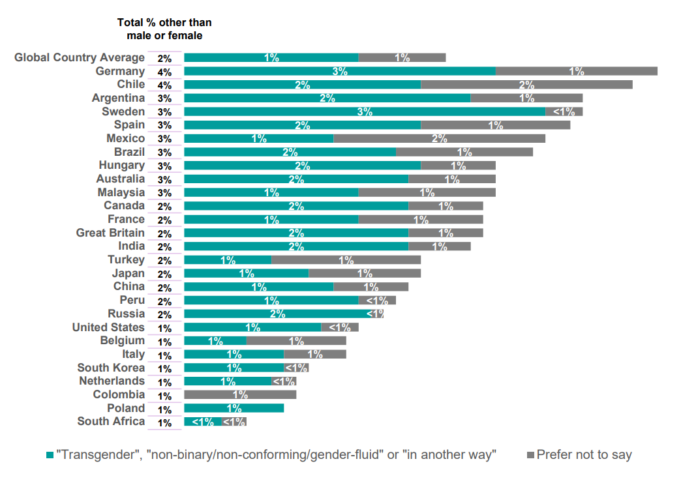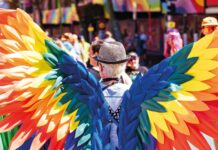- Germany and Sweden have the highest proportion of people identifying as other than male or female, a new Ipsos poll finds.
- Most of the 27 countries surveyed supported anti-discrimination laws and equal marriage and adoption rights.
- But opinion is divided on allowing transgender athletes to perform according to the gender they identify with.
Globally, 1% of adults currently describe themselves as transgender, non-binary, non-conforming, gender-fluid or “in another way”, rather than as male or female, according to a new survey.
More than 19,000 people, aged 16 to 74, were canvassed in 27 different countries between 23 April and 7 May for the Ipsos LGBT+ Pride 2021 Global Survey.
Of those adults surveyed, an average of 80% identified as heterosexual while 3% identified as gay, lesbian or homosexual. Four percent responded to say they were bisexual, 1% as pansexual or omnisexual, 1% as asexual, 1% as “other”, while 11% either don’t know or didn’t say.
Germany and Sweden have the highest proportion of people identifying as other than male or female, at 3%.
Here are some of the other key findings of the report:
Generation gap
A higher percentage of younger people described their gender as other than male or female, according to the survey.
Among ‘Generation Z’ – those born since 1997 who are no older than 24 – a global average of 4% of respondents identified as transgender, non-binary, non-conforming, gender-fluid, or “in another way” other than male or female.
The COVID-19 pandemic and recent social and political unrest have created a profound sense of urgency for companies to actively work to tackle inequity.
The Forum’s work on Diversity, Equality, Inclusion and Social Justice is driven by the New Economy and Society Platform, which is focused on building prosperous, inclusive and just economies and societies. In addition to its work on economic growth, revival and transformation, work, wages and job creation, and education, skills and learning, the Platform takes an integrated and holistic approach to diversity, equity, inclusion and social justice, and aims to tackle exclusion, bias and discrimination related to race, gender, ability, sexual orientation and all other forms of human diversity.
The Platform produces data, standards and insights, such as the Global Gender Gap Report and the Diversity, Equity and Inclusion 4.0 Toolkit, and drives or supports action initiatives, such as Partnering for Racial Justice in Business, The Valuable 500 – Closing the Disability Inclusion Gap, Hardwiring Gender Parity in the Future of Work, Closing the Gender Gap Country Accelerators, the Partnership for Global LGBTI Equality, the Community of Chief Diversity and Inclusion Officers and the Global Future Council on Equity and Social Justice.
Exposure to the community
On average, globally, 42% say they have a relative, friend or colleague who is lesbian, gay or homosexual, while exposure to the LGBT+ community is found to be more prevalent among women than men (47% vs 37%).
There are big variants between countries, however, with 66% in Brazil reporting having a gay or lesbian relative, friend or colleague, while that figure is just 7% in Japan and South Korea.
Support for equality
“Anti-discrimination laws and equal marriage and adoption rights for LGBT people are supported by majorities in most of the 27 countries,” says the report, “but are fiercely opposed in a few of them.”
On average, across all 27 countries, 54% support the right of LGBT people to marry legally, but Russia (52%) and Malaysia (65%) have majorities against legal recognition of same-sex relationships.
There have also been shifts in opinion: an average of 36% say their views on same-sex marriage have changed from five years ago.
Visibility varies
“On average, there is more support than opposition toward LGBT people displaying affection in public and more LGBT characters on TV, in films and in advertising,” says the report.
Support for people being open about their sexual orientation or gender identity is highest in Spain (73%), Argentina (69%) and Chile (68%), and lowest in Russia (12%) and Malaysia (14%).
A mixed picture for athletes
Half of those surveyed support lesbian, gay and bisexual athletes being open about their orientation.
“On the other hand, when it comes to allowing transgender athletes to perform according to the gender they identify with,” the report notes, “public opinion is divided and varies widely across countries.” On average, globally, only 32% support transgender athletes competing based on the gender they identify with, rather than the sex they were assigned at birth. The same percentage opposes it.
License and Republishing








